Polydesmida key
To identify Polydesmida to genus and species, it's necessary to understand their anatomy. I strongly recommend a visit to the External Anatomy of Polydesmida website. The site offers an illustrated guide to how Polydesmida are built and explains the anatomical terms used here.
The absolute basics are as follows:
H+20 vs H+19, and gonopods. Depending on species, adult Polydesmida have either 14 segments with two pairs of legs (H+20; segments 5-18), or 13 segments with two pairs of legs (H+19; segments 5-17). In both cases, a pair of specialised structures called gonopods replace the first pair of legs on segment 7, which in females carries the third set of "doubled" legs (see diagram). If you don't have an adult male with gonopods, it is often impossible to identify the specimen.

Paranota, ozopores and spiracles. Paranota (singular paranotum) are lateral extensions of the metatergite (see below). Spiracles are the holes through which a millipede breathes. On most segments there are two spiracles on each side, opening just above the leg bases. Ozopores are openings to the chemical defence glands. These open on the side of the body or on the paranota, one on each side and usually on rings 5, 7, 9, 10, 12, 13, and 15-18 (H+19) or 15-19 (H+20). This is called the "normal pore formula".

Note: For troglomorphic cave-dwelling millipedes, try Atalopharetra clarkei for Ida Bay, A. eberhardi for Precipitous Bluff and Noteremus infimus for the Junee-Florentine.
|
1a. Paranota broad and obvious (left-hand image)
|
 |
|
2a. Rear corner of paranotum clearly projecting backwards (left-hand image)
|
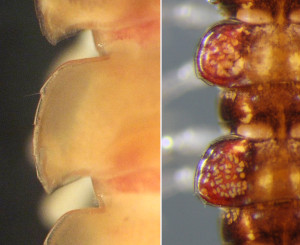 |
|
3a. Prominent long seta arising near rear corner of paranotum ("Lissodesmus group")
|
 |
|
4a. Spiracles large, seemingly swollen (top image; except Dasystigma tyleri), adult 20-25 mm long, pale brown or chestnut brown
|
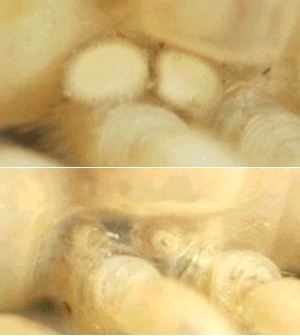 |
|
5a. Adults at least 15 mm long, reddish-brown; metatergites flat; found in bush areas
|
|
|
6a. Second tergite greatly expanded laterally (see image at right), metatergites covered with numerous tiny bumps, adults 5-7 mm long
|
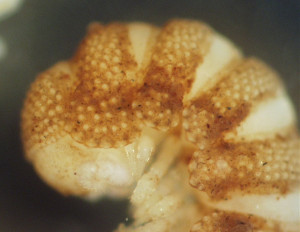 |
|
7a. Metatergites in adults smooth with 3 transverse rows of low bumps; animal dark reddish-brown; gonopods as shown (right)
|
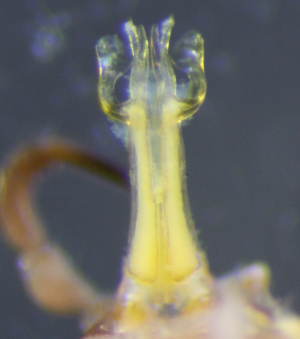 |
|
8a. Body usually well-pigmented (various colours); gonopods with large, rearwards-projecting "flange" (see image at right)
|
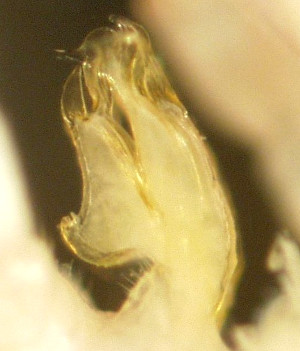 |
|
9a. Very long gonopods ending in 2-pronged fork (top image)
|
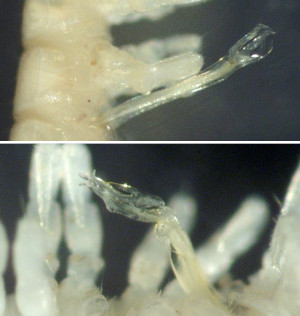 |
|
10a. Paranota visible as reduced structures or slight lateral swellings
|
|
|
11a. Paranota shaped as shown (head is to left)
|
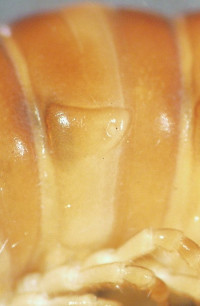 |
|
12a. Body light brown with well-defined dark brown ring around each ring and light paranota (introduced species; see image at right)
|
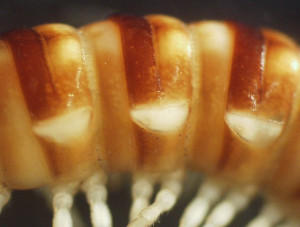 |
|
13a. Gonopod as shown (head is to right); eastern and northern Tasmania
|
 |
|
13b. Gonopod as shown (head is to right); eastern and northern Tasmania
|
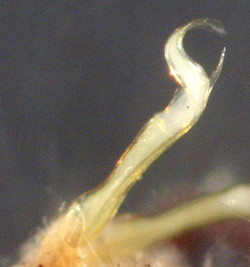 |
|
13c. Gonopod similar to the one shown (head is towards top); western and northern Tasmania
|
 |
|
14a. Adults to 12 mm long, pale red in colour; ozopores on rings 5 and 7-18
|
|
|
15a. Adults reddish brown or black, gonopod as shown (left-hand image); far northeast Tasmania and eastern Bass Strait
|
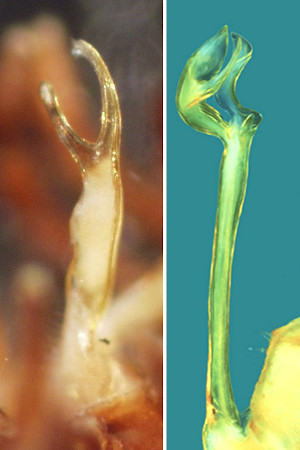 |
|
16a. Adults reddish, ozopores on rings 5 and 7-18, far south only
|
|
|
17a. Gonopod long, with "fringed hood" at tip and long, needle-like solenomere (see image at right; dashed line through solenomere)
|
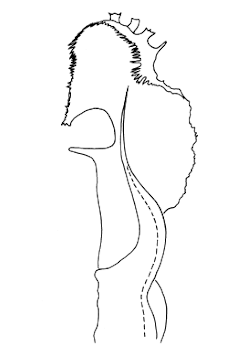 |
|
18a. Paranota reduced to a fine, just-visible line (see image on right)
|
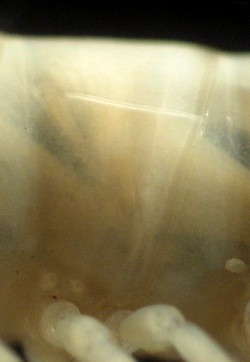 |
|
19a. Adults 20-25 mm long, pale with 3 dark longitudinal stripes (see image on right)
|
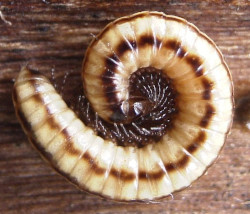 |
